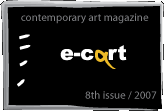Social Processes / Strategies of Learning / Why Children?
After 2001, the year that witnessed the transformation of Periferic from a performance festival into a contemporary art biennial, many voices raised the problem of the foundations of such an enterprise in Iasi, as long as, prima facie, this seemed to be a matter of a city pride, a city that lacked the necessary financial and cultural background that would grant legitimacy of inclusion in a certain circuit of contemporary culture. The truth was that the situation was worse than that, since the decision makers didn’t hurry to assume this project and all its implications. Yet, far from extinction, Periferic got better with every edition, due to the efforts of the Vector Association, the organizer of the biennial, who understood that the ontological structure of the world has changed with the latest events on the international arena, that put Iasi on a privileged position in the center of a marginal space shaped by the ex-soviet, ex-Yugoslav, central European and Middle East contexts.
Dealing with the context
It seems that if small biennials should be satisfied with only following an established western biennial format, they would be doomed to failure. Using an almost out-dated dichotomy (that of center and periphery) and paraphrasing the plot of a famous science-fiction story written by Isaac Asimov, I would say that the interesting things are happening not in the heart of the old Empire (the old Europe) but at its margins, a space politically delineated, but, culturally, still seeking for an identity-granting discourse. Following this, it seemed natural for Periferic that, with the passing of years, a new discourse, that would pay attention to all the new geopolitical coordinates, shall emerge. Thus, the 7th edition of Periferic gathered four curators that agreed to produce an artistic event which, under the title “Focusing Iasi”, would tackle certain economical, social, political and cultural problems of Iasi, as related to the local, regional and global context. The structure of Periferic 7 was formed by three different sections subsumed by different concepts: Social Processes, where the curators, Marius Babias and Angelika Nollert, re-appropriated the social reality of the city, seen as a transient process between emerging and fading social entities, so as to include what collective memory refuses to see; Strategies of Learning for which, newly immersed in the Romanian context, Florence Derieux constructed a discourse at the meeting point where art, extrapolated from its social influences and involvement, is the sole denominator for the imports and exports of information about the local context; and Why Children?, a reason for Attila Tordai-S. to emphasize the lack of political and social responsibility which has as a result children abandonment, whether this is a physical matter (institutionalized children) or an emotional one (parents that don’t have enough time to spend with their children).
Revisiting time and space
On the one hand, there is time which, as Mika Hannula emphasized in his Framework review (Issue 4/December 2005) of the Istanbul Biennial, seems to be a very serious enemy when organizing a biennial. The compulsion that the very concept of a biennial puts, that of an artistic event that has to be organized every second year, could affect the curatorial insights and artistic representations, being able, thus, to diminish the quality of the show. Truly speaking, three years have passed since the last edition of Periferic, but in the case of Iasi this was only a sign for a qualitative structural transformation: as the curators agreed, Periferic 7 should be seen more like an ongoing process in three stages (artists’ visits and documentation, the exhibition and the three reflecting catalogues – actually, in the case of Babias and Nollert, an impressive sourcebook with critical texts and artistic contributions) than like an ordinary exhibition which materializes discourses and artistic means of expression. In the case of Marius Babias and Angelika Nollert’s section, this assumed strategy was pushed to its limits, each of the eleven artists or artist groups that were invited, visited the city at least once since the autumn of 2005, the results constructing a unitary and coherent vision of the local issues.
On the other hand, there was the question of space, a really hard one, as long as the traditional and conservative city of Iasi doesn’t know yet how to deal with contemporary art. Periferic 7 was mounted in different venues, from those exhibiting places that served also the purposes of the previous editions (the Turkish Baths and the Palace of Culture), to new venues, such as Cupola Gallery (artists union’s gallery), The Museum of Natural Sciences and the Sports Hall of the George Enescu University. There is a long way down from nude projects to practices of elaboration, and once you step in one of these venues you cannot help noticing that serious work has been done in order to cope with the symbolic level of the designed places. Thus, while Babias, Nollert and Derieux succeeded in neutralizing the historical weight of the Turkish Baths and of the Palace of Culture, Tordai courageously pursued to change the space, mounting white cubes for screening in the unusual space of a sports hall.
The artists
I cannot help putting an emphasis on the works made by some of the artists, and my sole criterion, although subjective but grounded in the socio-cultural landscape, will be that of the effort put in the process of understanding, working with, and artistically reflecting the complex reality of the city of Iasi. So was the Romanian artist Ciprian Mureşan who, through his work Rhinoceros, continued his pursue of granting new meanings to culturally shared artistic paradigms, this time engaging children from a local primary school to adapt the play with the same title written by Eugene Ionesco, transforming a cold tale of absurdity into an appropriate, familiar story. The duo Bik van der Pol was interested in, and made a video documentation of people from Iaşi who, in an age of mass reproduction, are still making a living through manufacturing common goods (such as constructing mouse-traps, repairing umbrellas and old clocks, etc.) sold in the local Bazaar. Latifa Echakch worked with eleven students from the University of Arts in Iasi in producing a linoleum floor-covering for the Palace of Culture, upon which, using the technique of lino-cutting, they made a textual retrospective of the so little known Romanian avant-garde. Laura Horelli, who spent almost one month researching the local context of Iasi, succeeded in producing a documentary film that unveiled aspects the collective memory prefers to forget, such as the Jewish Pogrom, when, between 28th and 30th of June 1941, 12.000 Jews were killed in Iasi. Luchezar Boyadjiev was interested in studying and comparing through textual and photographic means the visual interface of the city, that is, the ways in which social spaces communicate with one another, under the pressure of aggressive advertisement imposed by the rules of wild neo-capitalism. Besides the alternative hand-book designed for the art students, the group H.arta made an intervention in the public space of the city, placing posters containing broad questions about art and its putative meanings, questions that would perform in putting a simple walker into a reflective mood. In the Turkish Baths, Dan Perjovschi covered with his famous doodles and political graffiti an almost entire floor, while at an inferior level of the building, the young artist Andrea Faciu was constructing a work in progress on paper to be completed by the visitors themselves, an invitation to mentally reinvent and destroy in the same time the dysfunctional system(s) of the Romanian society. A great idea was to include in the Social Processes exhibition the VAD archive (Vector Art Data Bank), a project in process which aims to scan the artistic scenes of the surrounding East-European countries, and which included materials from magazines and leaflets to video and documentary films. In the end, I would mention two other events which highlighted the opening days of the biennial: the first one is the IDEA platform panel discussion held at Goethe Zentrum in Iasi, where Adrian T. Sîrbu, Ovidiu Țichindeleanu, Zsuzsa Selyem, Ciprian Mihali, Matei Georgescu and Bogdan Ghiu professed a comprehensive hermeneutical approach towards the large-scale phenomena of children abandonment; the other event is the premiere hosted by the Turkish Baths of the theater play Țapţarap written by Nicoleta Esinencu, a very provocative piece that deals with the social effects of religion in post-communist times.
Periferic 7 – Focusing Iasi
International Biennial for Contemporary Art
Iasi, Romania,
12–30 May, 2006
Social Processes
Luchezar Boyadjiev, Boris Buden and Hito Steyerl, Nicoleta Esinencu, Andrea Faciu, H.arta, Christine and Irene Hohenbüchler, Laura Horelli, John Miller, Dan Perjovschi, Lia Perjovschi, Vector Art Data Bank
Curators: Marius Babias and Angelika Nollert
Strategies of Learning
Sandy Amerio, Bik van der Pol, Valentin Carron, Latifa Echakhch, Jens Haaning, Pierre Joseph, Mattias Olofsson, Sean Snyder, Simon Starling, Andrei Ujica and Harun Farocki
Curator: Florence Derieux
Why Children?
Big Hope, Mircea Cantor and Gabriela Vanga, Ciprian Muresan, Elke Marhöfer, Ioana Nemes, Katya Sander, Nedko Solakov, Bessenyei Hajnalka and Nita Mocanu, Péter Szabó
Curator: Attila Tordai-S.
Vlad Morariu
This text was first published in Framework, Issue 5/ July ’06




















